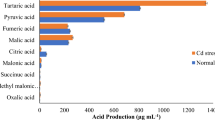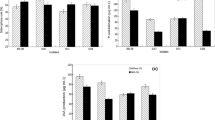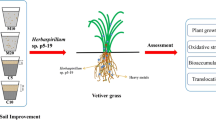Abstract
This study investigated the phytoremediation potential of maize (Zea mays L.) in Cd-contaminated soil through co-inoculation of metal-tolerant plant beneficial rhizobacteria (MtPBR: Pantoea sp. strain WP-5) with organic manures (PM, poultry manure, and BGR, biogas residues). The objectives of this study were to (i) examine comparative efficiency of MtPBR, PM and BGR alone or in combined form to improve maize biomass and physiology and (ii) understand the role of organic acid production in root exudates of maize for Cd accumulation and translocation. Pantoea sp. WP-5 showed organic acid production and tolerance to high Cd concentration (1000 mg L-1), thereby inoculated to maize seeds sown in soil spiked with 75 mg Cd kg-1 soil and 500 g each of the organic manures per pot. The co-inoculation of MtPBR + BGR significantly (P<0.05) increased chlorophyll contents, root/shoot dry weight, photosynthetic rate, stomatal conductance, and relative water contents and decreased electrolyte leakage, malondialdehyde contents, ascorbate peroxidase, and catalase activity in maize over the control treatment. The co-inoculation of MtPBR + BGR produced significantly (P<0.05) higher concentrations of acetic and citric acid (52.7±0.5 and 22.8±0.08 μg g-1 root fwt, respectively) in root exudates of maize, which immobilized Cd within plant roots inferred by the positive relation (root Cd vs. organic acids; R2 = 0.80-0.92) and reduced Cd translocation to shoots inferred by the negative relation (shoot Cd vs. organic acids; R2 = 0.81-0.90). It is concluded that the application of MtPBR + BGR enhanced organic acid induced phytostabilization and accumulation of Cd in roots and restricted its translocation to shoots.




Similar content being viewed by others
Data Availability
The authors confirm that the data supporting the findings of this study are available within the article [and/or] its supplementary materials.
References
Abubaker J, Risberg K, Pell M (2012) Biogas residues as fertilizers – Effects on wheat growth and soil microbial activities. Appl Energy 99:126–134
Aebi H (1984) Catalase in vitro. Methods Enzymol 105:121–126
Ahmad I, Akhtar MJ, Zahir ZA, Naveed M, Mitter B, Sessitsch A (2014) Cadmium tolerant bacteria induce metal stress tolerance in cereals. Environ Sci Pollut Res 21:11054–11065
Ahmad I, Akhtar MJ, Zahir ZA, Mitter B (2015) Organic amendments: Effects on cereals growth and cadmium remediation. Int J Environ Sci Technol 12:2919–2928
Ahmad I, Akhtar MJ, Mehmood S, Akhter K, Tahir M, Saeed MF, Hussain MB, Hussain S (2018) Combined application of compost and Bacillus sp. CIK-512 ameliorated the lead toxicity in radish by regulating the homeostasis of antioxidants and lead. Ecotoxicol Environ Saf 148:805–812
Ahmad I, Tahir M, Daraz U, Ditta A, Hussain MB, Khan ZUH (2020) Responses and tolerance of cereal crops to metal and metalloid toxicity. In: Hasanuzzaman M (ed) Agronomic Crops. Springer, Singapore, pp 235–264
Akhtar MJ, Ali Q, Javid R, Asghar HN, Ahmad I, Iqbal MZ, Khaliq A (2019) Organic and inorganic amendments immobilized cadmium and improved maize growth and yield in Cd-contaminated soil. Int J Agric Biol 22:1497–1506
An Y-J (2004) Soil ecotoxicity assessment using cadmium sensitive plants. Environ Pollut 127:21–26
Anjum SA, Tanveer M, Hussain S, Shahzad B, Ashraf U, Fahad S, Hassan W, Jan S, Khan I, Saleem MF, Bajwa AA, Wang L, Mahmood A, Samad RA, Tung SA (2016) Osmoregulation and antioxidant production in maize under combined cadmium and arsenic stress. Environ Sci Pollut Res 23:11864–11875. https://doi.org/10.1007/s11356-016-6382-1
Antoniadis V, Golia EE, Liu Y-T, Wang S-L, Shaheen SM, Rinklebe J (2019) Soil and maize contamination by trace elements and associated health risk assessment in the industrial area of Volos. Greece Environ Inter 124:79–88. https://doi.org/10.1016/j.envint.2018.12.053
Ayers RS, Westcot DW (1985) Water quality for agriculture, FAO Irrigation and Drainage Paper 29 rev 1. FAO, UN, Rome p 174
Bali AS, Sidhu GPS, Kumar V (2020) Root exudates ameliorate cadmium tolerance in plants: A review. Environ Chem Lett 18:1243–1275
Ben-Asher J, Tsuyuki I, Bravdo BA, Sagih M (2006) Irrigation of grapevines with saline water: I. Leaf area index, stomatal conductance, transpiration and photosynthesis. Agric Water Manag 83:13–21
Berni R, Luyckx M, Xu X, Legay S, Sergeant K, Hausman JF, Lutts S, Cai G, Guerriero G (2019) Reactive oxygen species and heavy metal stress in plants: impact on the cell wall and secondary metabolism. Environ Exp Bot 161:98–106
Chen C, Li Z, Li S, Deng N, Mei P (2020) Effects of root exudates on the activation and remediation of cadmium ion in contaminated soils. Environ Sci Pollut Res 27:2926–2934. https://doi.org/10.1007/s11356-019-07263-8
Georgiadou EC, Kowalska E, Patla K, Kulbat K, Smolinska B, Leszczynska J, Fotopoulos V (2018) Influence of heavy metals (Ni, Cu, and Zn) on nitro-oxidative stress responses, proteome regulation and allergen production in basil (Ocimum basilicum L.) plants. Front Plant Sci 9:862. https://doi.org/10.3389/fpls.2018.00862
Hasan MM, Nashir-Uddin M, Ara-Sharmeen I, Alharby HF, Alzahrani Y, Hakeem KR, Zhang L (2019) Assisting phytoremediation of heavy metals using chemical amendments. Plants (Basel) 8(9):295. https://doi.org/10.3390/plants8090295
Heath RL, Packer L (1968) Photoperoxidation in isolated chloroplasts: I. Kinetics and stoichiometry of fatty acid peroxidation. Arch Biochem Biophys 125:189–198
Javed MT, Akram MS, Tanwir K, Javed Chaudhary H, Ali Q, Stoltz E, Lindberg S (2017) Cadmium spiked soil modulates root organic acids exudation and ionic contents of two differentially Cd tolerant maize (Zea mays L.) cultivars. Ecotoxicol Environ Saf 141:216–225
Khurana MPS, KansaL BD (2014) Effect of farmyard manure on chemical fractionation of cadmium and its bioavailability to maize crop grown on sewage irrigated coarse textured soil. J Environ Biol 35:431–437
Latif J, Akhtar J, Ahmad I, Mahmood-Ur-REhman M, Shah GM, Zaman Q, Javaid T, Farooqi ZUR, Shakar M, Saleem A, Rizwan M (2020) Unraveling the effects of cadmium on growth, physiology and associated health risks of leafy vegetables. Brazilian Journal of Botany 43:799–811. https://doi.org/10.1007/s40415-020-00653-0
Lichtenthaler HK (1987) Chlorophylls and carotenoids: Pigments of photosynthetic biomembranes. Methods in Enzymology, Academic Press 148:350–382
Lux A, Lackovic A, STaden VJ, Liskova D, Kohanova J, Martinka M (2015) Cadmium translocation by contractile roots differs from that in regular, non-contractile roots. Ann Bot 115:1149–1154
Moreira H, Marques AP, Franco AR, Rangel AO, Castro PM (2014) Phytomanagement of Cd-contaminated soils using maize (Zea mays L.) assisted by plant growth-promoting rhizobacteria. Environ Sci Pollut Res 21:9742–9753
Most P, Papenbrock J (2015) Possible roles of plant sulfurtransferases in detoxification of cyanide, reactive oxygen species, selected heavy metals and arsenate. Molecules. 20:1410–1423
Mostofa KM, LIU CQ, Feng X, Yoshioka T, Vione D, Pan X, Wu F (2013) Complexation of dissolved organic matter with trace metal ions in natural waters. In: Mottaleb A, Mostofa MGK (eds) Photo-biogeochemistry of Organic Matter, pp 769–849
Najeeb U, Jilani G, Ali S, Sarwar M, Xu L, Zhou W (2011) Insights into cadmium induced physiological and ultra-structural disorders in Juncus effusus L. and its remediation through exogenous citric acid. J Hazard Mater 186:565–574
Nakano Y, Asada K (1981) Hydrogen peroxide is scavenged by ascorbate-specific peroxidase in spinach chloroplast. Plant Cell Physiol 22(5):867–880
Pirselova B, Kuna R, Libantova J, Moravcikova J, Matusikova I (2011) Biochemical and physiological comparison of heavy metal-triggered defense responses in the monocot maize and dicot soybean roots. Mol Biol Rep 38:3437–3446
Potysz A, Grybos M, Kierczak J, Guibaud G, Fondaneche P, Lens PN, Van Hullebusch ED (2017) Metal mobilization from metallurgical wastes by soil organic acids. Chemosphere 178:197–211
Puertas-Mejia MA, Ruiz-Diez B, Fernandez-Pascual M (2010) Effect of cadmium ion excess over cell structure and functioning of Zea mays and Hordeum vulgare. Biochem Syst Ecol 38:285–291
Putwattana N, Kruatrachue M, Kumsopa A, PokethitiyooK P (2015) Evaluation of organic and inorganic amendments on maize growth and uptake of Cd and Zn from contaminated paddy soils. Int J Phytoremediat 17:165–174
Rehman ZU, Khan S, Brusseau ML, Shah MT (2017) Lead and cadmium contamination and exposure risk assessment via consumption of vegetables grown in agricultural soils of five-selected regions of Pakistan. Chemosphere. 168:1589–1596. https://doi.org/10.1016/j.chemosphere.2016.11.152
Rizwan M, Ali S, Qayyum MF, Ok YS, Zia-ur-Rehman M, Abbas Z, Hannan F (2016) Use of Maize (Zea mays L.) for phytomanagement of Cd-contaminated soils: a critical review. Environ Geochem Health 39:259–277. https://doi.org/10.1007/s10653-016-9826-0
Sangthong C, Setkit K, Prapagdee B (2015) Improvement of cadmium phytoremediation after soil inoculation with a cadmium-resistant Micrococcus sp. Environ Sci Pollut Res. https://doi.org/10.1007/s11356-015-5318-5
Sethi S, Gupta S (2015) Responses of soil enzymes to different heavy metals. Biolife. 3(1):147–153
Shumba A, Marumbi R, Nyamasoka B, Nyamugafata P, Nyamangara J, Madyiwa S (2014) Mineralisation of organic fertilizers used by urban farmers in Harare and their effects on maize (Zea mays L.) biomass production and uptake of nutrients and heavy metals. S Afr J Plant Soil 31:93–100
Steel RGD, Torrie JH, Deekey ANDDA (1997) Principles and procedures of statistics: a biometrical approach, 3rd edition, pp: 400–428. McGraw Hill Book, New York, USA
Tahir M, Mirza MS, Zaheer A, Dimitrov MR, Smidt H, Hameed S (2013) Isolation and identification of phosphate solubilizer’ Azospirillum, Bacillus and Enterobacter strains by 16SrRNA sequence analysis and their effect on growth of wheat (Triticum aestivum L.). Aust J Crop Sci 7:1284–1292
Tahir M, Mirza MS, Hameed S, Dimitrov MR, Smidt H (2015) Cultivation-based and molecular assessment of bacterial diversity in the rhizo sheath of wheat under different crop rotations. PLoS One 10:e0130030
Tahir M, Khalid U, Ijaz M, Shah GM, Naeem MA, Shahid M, MahmooD K, AhmaD N, Kareem F (2018) Combined application of bio-organic phosphate and phosphorus solubilizing bacteria (Bacillus strain MWT 14) improve the performance of bread wheat with low fertilizer input under an arid climate. Braz J Microbiol 49(1):15–24
Tahir M, Asif Naeem M, Shahid M, Khalid U, Umer Farooq AB, Ahmad N, Ahmad I, Arshad M, Waqar A (2020) Inoculation of pqqE gene inhabiting Pantoea and Pseudomonas strains improve the growth and grain yield of wheat with a reduced amount of chemical fertilizer. J Appl Microbiol 129:575–589. https://doi.org/10.1111/jam.14630
Wang A, Wang M, Liao Q, He X (2016) Characterization of Cd translocation and accumulation in 19 maize cultivars grown on Cd-contaminated soil: implication of maize cultivar selection for minimal risk to human health and for phytoremediation. Environ Sci Pollut Res Int 23(6):5410–5419. https://doi.org/10.1007/s11356-015-5781-z
Waseem A, Arshad J, Iqbal F, Sajjad A, Mehmood Z, Murtaza G (2014) Pollution status of Pakistan: a retrospective review on heavy metal contamination of water, soil, and vegetables. BioMed Res Inter 2014:1–29. https://doi.org/10.1155/2014/813206
Xu W, Lu G, Dang Z, Liao C, Chen Q, Yi X (2013) Uptake and distribution of Cd in sweet maize grown on contaminated soils: A field-scale study. Bioinorg Chem Appl 2013:1–8. https://doi.org/10.1155/2013/959764
Funding
The work is partially supported by the Higher Education Commission of Pakistan under SRGP grant.
Author information
Authors and Affiliations
Contributions
MT, IA, AD: writing—original draft preparation, methodology, investigation; UK, MA, MK: methodology, resources, and analysis; MS, MBK: writing—reviewing and editing; MT, IA: conceptualization, resources, supervision.
Corresponding authors
Ethics declarations
Ethics approval and consent to participate
This study does not involve any humans or animals during experimentation, so it does not applicable in this study.
Consent for publication
This study does not contain data from any individual person, please state so it does not applicable in this section.
Competing interests
The authors declare that they have no known competing financial interests or personal relationships that could have appeared to influence the work reported in this paper.
Additional information
Responsible Editor: Elena Maestri
Publisher’s note
Springer Nature remains neutral with regard to jurisdictional claims in published maps and institutional affiliations.
Supplementary Information
ESM 1
(DOC 5348 kb)
Rights and permissions
About this article
Cite this article
Tahir, M., Khan, M.B., Shahid, M. et al. Metal-tolerant Pantoea sp. WP-5 and organic manures enhanced root exudation and phytostabilization of cadmium in the rhizosphere of maize. Environ Sci Pollut Res 29, 6026–6039 (2022). https://doi.org/10.1007/s11356-021-16018-3
Received:
Accepted:
Published:
Issue Date:
DOI: https://doi.org/10.1007/s11356-021-16018-3




